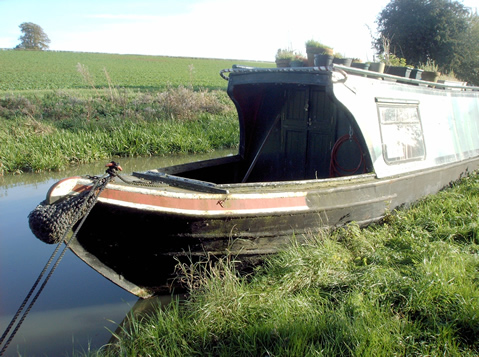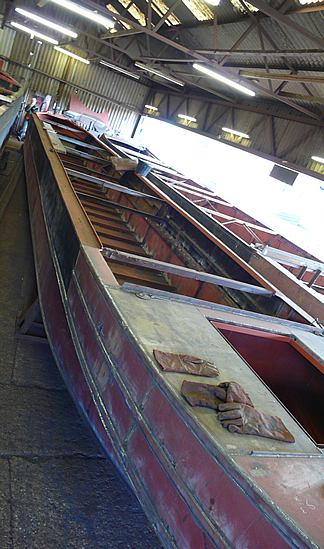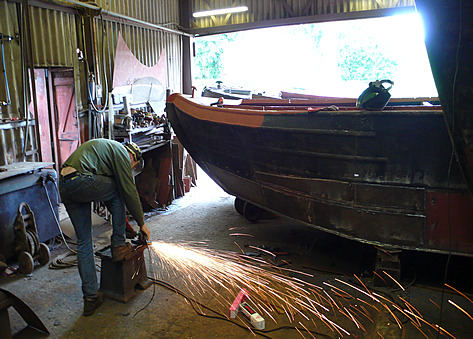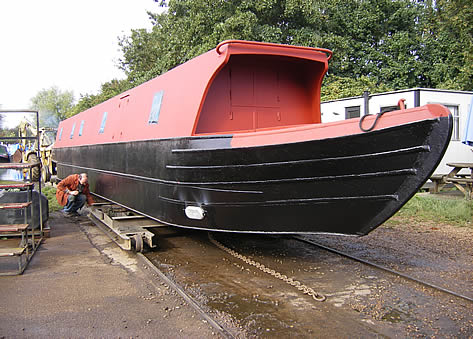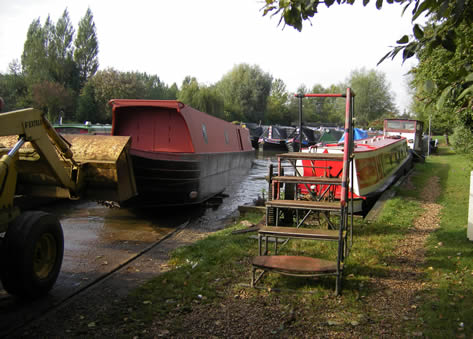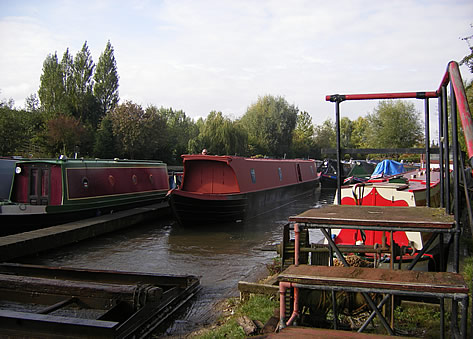
| Front Page | Ancient Instruments | Kornukopia Crafts | Music & Performance | Teaching & Workshops | Pilgrimage | The Bear Tribe | Hobbies & Articles | Contact & Links |
Kate and Corwen's Narrowboat Challenge...
This is our page for sharing pictures and news concerning the rebuilding of Kate's narrowboat, the Duke of Bridgewater. Kate bought the Duke 15 years ago. Before that it was owned for 25 years by Terry Every, an important figure in the Canal Restoration movement. Before him it belonged to a man who left the UK to become a Bishop in Australia.
The Duke was built in 1957 by Dami Marine in Liverpool, no-one knows whether as a working boat or a pleasure boat. The bow shape is unusual and people have speculated over the years as to the original purpose of the boat. When it was built it was around 30' in length but was "stretched" to 62 feet some time later. We discovered during the removal of the old cabin that the bow of the boat had been cut off just behind the front bulkhead and an additional 30 feet of hull welded in. Don't worry this is perfectly normal for narrowboats! British Standard labels on the timber seem to suggest that this happened in the late 60's or early 70's.
The Duke's distinctive signwriting.
While being stretched the gap between the old back cabin and front bulkhead was closed with a new section of plywood. The old roof was enclosed with ply, the space between the handrails filled with polystyrene and junk timber. Until we discovered this we had wondered why the roof in places was 5" thick. During the stretch the whole of the new cabin section, and the remains of the old back cabin were clad in aluminium. This is now considered bad practice as the enclosed wood cannot breathe, and this cladding ultimately led to the deterioration of the cabin necessitating its replacement by us!
The red part is the remains of the original back cabin.
The old handrails of the back cabin, buried in ply after the stretch.
We stripped out the entire inside of the cabin, removing all the insulation. 40 bin bags of polystyrene! Sadly not re-usable as it doesn't comply with present fire regulations. Karen, Kev and Diane kindly took it to the tip for us.
Kate pulling some polystyrene out of the cabin lining.
Almost done, the hull is now visible. The brown box amidships is the Rayburn, this will be craned out once the roof is off.
After cutting off all the services (gas, water etc) and emptying the cabin it was time to remove the cabin itself. All the windows were unscrewed and the aluminium cladding pulled off.
Removing the aluminium cladding.
Under the aluminium we found old paintwork, including some signwriting. This confirms that the boats name hasn't been changed, which is nice to know. The Duke seems to have been painted five times, green and black twice, pillar box red, then after cladding red again, then (by Kate and her brother Colin) purple, and then back to the original green and black by Kate (spooky, as she didn't know it had been that colour originally at the time).
Corwen retires to a safe distance while the cabin collapses. Gongoozlers look on with awe... Finally Corwen attacked the supporting uprights with an axe, collapsing the cabin, though the old back cabin and its bulkhead were left standing to protect the engine. There then followed the long job of cutting the cabin up into manageable pieces and getting it out of the hull and into piles to be disposed of. Luckily Kate's friend Cliff came to help. For a peaceful guy he wields a mean axe!
Cliff and Corwen lifting part of the cabin out of the hull.
The Duke's bare hull. Note how much higher the prow is out of the water. It draws about 1" at the bow now.
Now the boat is stripped back to the bare hull. It has an engine, and a water tank, but not a lot else. Its still our lovely Duke though! In mid April the boat was slipped out and moved into a very large shed. The news from the surveyor wasn't good, the bottom of the boat was shot, the back end not much better. The 5mm steel the Duke was made of had served well for 50 years, but just didn't have any life left in it. We were in a quandry... The surveyor recommended cutting the front 12 feet off and building a new boat on the back! Roger in the boatyard said it wasn't worth overplating the bottom as it would cost too much, and wouldn't last long with the old rusty bottom left in place... Then Roger came up with a new solution, he would keep the front and the sides and gunnels above the waterline, and replace the bottom and build a new back end from scratch. This would be cheaper than overplating or sticking the old front end onto a new build, would give us a new back end and better designed engine room and swim (the bit where the propeller lives under the water) which were pretty crap on the old hull. The boat would essentially look the same, preserving the characterful wobbly gunnels and beautiful bow, but would hopefully last another 50 years. We were sold, and work started, very slowly, to give us time to earn enough money to pay for the job! Thankfully Roger had room in his yard to work around the boat. His patience and understanding saved a boat that would doubtless have been scrapped had it been in a yard where boat storage was charged by the day.
Its tricky to photograph something 60 feet long in an enclosed space... Just as well Corwen's levitation is coming on. Here you can see the new back end and bottom. The rusty bit in the middle is a bit of the original boat. Don't worry, we took the rust off before we painted it with bitumen.
You can see where the old bow (partially overplated below the waterline) and gunnels and sides meet the new bottom (the red bit).
We saved a bit of cash by doing some tedious jobs ourselves, like angle grinding the gunnels, painting the metal ballast, painting the engine room, cleaning the engine, painting the hull...
hmmm smells good...
Shiny shiny!
After a month or two the cabin sides were on. The inside was still full of props and temporary struts to hold the roof and sides in position while being welded.
Sponsored by Acro...
Suddenly, with the front of the cabin shaped and the old 'idiot bar' welded back on, the Duke started to look like its old self again. Roger had carefully measured the old cabin shape, and did a fantastic job of duplicating the wooden cabin shape in steel. If you haven't seen a lot of narrowboats then it might not look like much, but for us this 'inspection launch' style overhang and stable doors was the soul of the Duke. It's practical too, the bar makes it easy to get on and off, and gives you somewhere to put tinsel at Christmas! The overhang means the doors can be left open even in the rain.
The idiot bar. This is meant to protect a wooden cabin from damage by accidental collisions with bridges, there is no need for it on a steel boat.
And how it used to look.
We also had Roger recycle the old bollards (mushroom shaped things, left and right), diesel filler cap and swans neck (the green stripy thing in the middle). Corwen cut them off the old hull with an angle grinder.
Thats the bottom of the boat, all black and shiny. Won't stay that way for long!
Nice new rudder, but the same old propeller.
The open semi trad back deck is an improvement on the narrow hatch that used to be there.
All the props were gone, the doors were fitted and it was done! Justin had installed the engine for us and so we were ready to go. Seven months in the yard...
Afloat at last! Riding high without any ballast. The next job was to put some ballast in. Kate and I found a reclamation yard nearby that would sell us reclaimed concrete slabs. We were determined to use reclaimed concrete as producing new concrete emits huge quantities of CO2, almost as much per ton as steel! We bought 40 of the biggest concrete slabs we could find, 600 x 900 mm, and 50 mm thick. They fitted nicely between the floor beams, balanced on tile spacers to let any condensation run underneath. They were so heavy it was only just possible for the two of us to lift them and carry them into the boat! It made the boat look like a floating patio. It still wasn't quite enough to get the swim properly under (essential to avoid cavitation), and so we added six massive steel girders that were part of the original weird ballast from the Duke's previous incarnation.
Kate, her brother Colin and his wife Jane and Corwen (behind the camera) motor away from the yard.
The next morning was tremendously misty.
Plastic sheeting where there ought to be portholes. We headed south, eventually to moor alongside Colin and Jane, where we could get on with the fitting out with the kind use of Colin's generator. And thats what we're doing now. More pictures coming soon!
|

